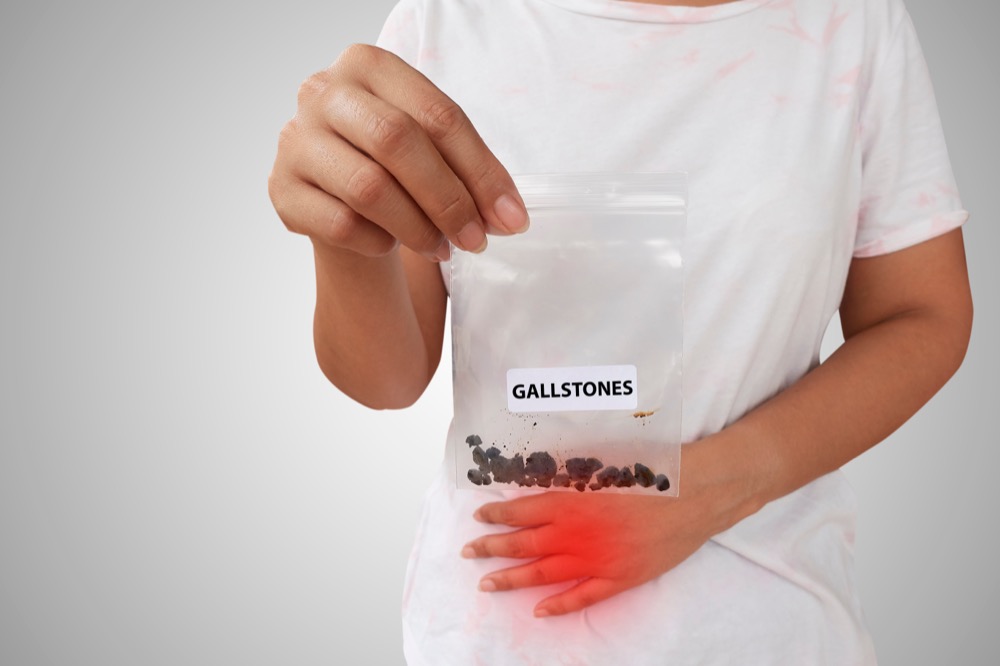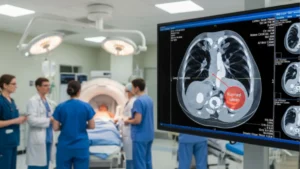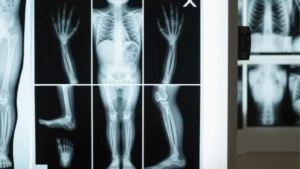Abdominal pain is one of the most familiar gallstone symptoms. The discomfort could be in the upper right side of the abdomen, it will come and go, and the pain level could be intense. The pain may also run all the way to the back or chest.
Is the symptom familiar to you? If yes, have yourself diagnosed as soon as possible because gallstones left untreated can lead to various complications that can harm your health. And to help you get started, this article will walk you through the processes of diagnosing gallstones.
What is the gallbladder?
The gallbladder is a little, pear-shaped organ in the upper right side of the abdomen beneath the liver. Its main job is to store and concentrate bile, a digestive fluid created by the liver that aids in breaking fats in the small intestine.
The gallbladder releases bile when food enters the small intestine through the cystic duct, a tiny duct that joins the common bile duct, which transports bile to the small intestine. Bile helps to emulsify fats and make them more easily absorbed by the body.
One can live without a gallbladder because it is not an essential organ. However, its removal might occasionally result in digestive problems that may call for dietary changes or medical treatment.
Gallbladder Disease: When Diagnostic Tests Are Needed
Only when a person exhibits symptoms are diagnostic testing for gallbladder issues performed. Here are some situations where a diagnosis of gallbladder disease may require diagnostic tests:
Abdominal pain
If you are experiencing abdominal pain, especially in the upper right quadrant of the abdomen, your doctor may order diagnostic tests to determine the cause. Abdominal pain is a common symptom of gallbladder disease, but other conditions can also cause it, so further testing may be necessary to diagnose it.
Nausea and vomiting
Additionally, typical signs of gallbladder illness include nausea and vomiting, particularly if they are accompanied by stomach pain. These signs and symptoms could point to acute cholecystitis, a disorder marked by gallbladder inflammation.
Jaundice
When the bile ducts are obstructed, it can result in jaundice, which is a yellowing of the skin and eyes. This can be caused by gallstones, which can block bile flow from the liver to the small intestine.
Abnormal blood tests
Blood tests can be done to screen for high liver enzyme levels, which may point to a gallbladder or bile duct issue.
How do doctors diagnose gallstones?
For the diagnosis of gallstones, doctors use a variety of tests. These include the following:
Medical History
If your doctor suspects gallbladder disease, he will ask you about your symptoms and whether anyone in your family has ever experienced gallbladder issues. Your physician will also let you further explain your symptoms’ period and severity.
Physical Examination
The doctor you see will do a physical examination, focusing on your vital signs first. Acute cholecystitis patients may have a fever and a rapid heartbeat.
Your doctor will see whether or not a condition known as “guarding” is present during an abdominal exam. A person with acute cholecystitis may feel tightening and spasming of the abdominal wall muscles to “guard” inflamed organs when the belly is pressed against.
Labs
Blood tests can check for signs of infection or inflammation, as well as elevated levels of liver enzymes, which may indicate a problem with the gallbladder or bile ducts.
The white blood cell count is frequently increased in people with gallbladder disease. Your white blood cells are your body’s infection-fighting cells, and when they are increased, they indicate that the body may be inflamed or infected. A person may also have high liver function tests and an elevated white blood cell count.
While there may be a slight increase in liver enzymes, an increase in the bilirubin level, which is a component of the liver function blood test, indicates a potential gallbladder disease complication (for instance, if a gallstone is obstructing the bile duct or if the bile duct is infected).
Imaging
Obtaining an abdominal ultrasound (and other imaging tests) is the most crucial step in the diagnostic procedure.
The latest imaging tests are available at One Step Diagnostic, a radiology center recognized by the American College of Radiology (ACR) with multiple locations across Texas.
Ultrasound
Sound waves are used in an ultrasound test to capture gallbladder images. The best way to check for gallstones is with this simple, non-invasive procedure.
Gallstones within the gallbladder can be easily seen by ultrasound, as can symptoms such as a thicker gallbladder wall that indicate gallbladder inflammation.
To schedule an ultrasound appointment, contact One Step Diagnostic or make an appointment online.
Liver function tests
Even though these tests aren’t done especially for gallstone disease, a simple blood test examining the liver’s enzyme levels can reveal gallstone-induced gallbladder inflammation.
If the gallbladder ruptures and gallstones obstruct the bile duct, which can cause jaundice, other combinations of liver tests are scheduled.
Complete blood count
The white blood cell count is typically increased when gallstones bring on inflammation. The patient in this circumstance frequently has a fever.
Computed tomography
A CT scan is a more thorough imaging test that utilizes x-rays and computer technology to produce detailed images of the gallbladder and surrounding structures.
HIDA scan
A HIDA scan is a specialized imaging procedure that tracks the passage of bile via the gallbladder and bile ducts using a radioactive dye.
This examination can aid in assessing the gallbladder’s performance and locating any obstructions or anomalies.
Magnetic resonance cholangiopancreatography
The bile ducts, gallbladder, and pancreatic duct can all be seen in great detail during magnetic resonance cholangiopancreatography (MRCP), a non-invasive imaging procedure.
It is especially important to check the bile ducts for any indications of gallbladder stones that have escaped and may be obstructing the bile duct and causing jaundice.
Endoscopic retrograde cholangiopancreatography
A tube is inserted down the patient’s throat, stomach, and small intestine. After dye injection, the liver, pancreas, and gallbladder ducts are visible on an X-ray.
ERCP is primarily utilized to treat patients with pancreatitis, jaundice, or cholangitis because a gallstone has blocked the bile duct.
Differential Diagnosis
A healthcare professional will conduct a differential diagnosis when a patient exhibits symptoms related to gallstones to identify the underlying cause of the symptoms.
There are other etiologies to take into account, mainly liver issues. This is because a network of biliary ducts connects your gallbladder to your liver, which is likewise situated on the upper right side of your belly.
Biliary colic, cholecystitis, choledocholithiasis, peptic ulcer disease, and GERD may be included in the differential diagnosis of gallstones.
To identify the underlying cause of a person’s symptoms, a healthcare professional will ask about the patient’s complete medical history, perform a physical examination, and order diagnostic testing.
What are potential gallbladder problems?
The following are common conditions and ailments related to the gallbladder.
- Inflammation: Inflammation, often known as cholecystitis, can be acute or chronic.
- Gallstones: Gallstones are calcified cholesterol deposits that can obstruct the gallbladder’s drainage system or cause an infection. A gallstone that passes into the intestine could be fatal.
- Infected bile duct: Your risk of infection increases if your bile duct is blocked.
- Polyps: Polyps are benign growths with a chance of turning cancerous.
- Porcelain Gallbladder: Porcelain gallbladder is a condition in which the inner lining of the gallbladder becomes covered with calcium deposits.
It is crucial to visit a healthcare professional if you are exhibiting any gallbladder-related symptoms. Have yourself checked to identify the underlying reason and the best course of action.
Signs of gallbladder problems
Numerous symptoms and indicators might be linked to gallbladder issues. Here are a few typical symptoms of gallbladder issues:
- The most prevalent gallbladder symptom is abdominal pain, which is often felt in the upper right or middle of the abdomen. The duration of the pain might range from a few minutes to many hours, and it can be mild to severe.
- Nausea and vomiting are common symptoms of gallbladder problems, often occurring in conjunction with abdominal pain.
- Some people with gallbladder issues may feel uncomfortable after eating fatty or oily foods and may also experience bloating and gas.
- As the gallbladder produces bile that aids in the digestion of fat, indigestion, and heartburn can potentially be signs of gallbladder issues.
- A blockage in the bile ducts can cause jaundice, which is a yellowing of the skin and eyes. This can indicate a more severe gallbladder issue, including gallbladder cancer.
Early Detection Always Matters
In conclusion, a combination of medical history, physical examination, blood testing, and imaging tests may be used to diagnose gallstones.
For a correct diagnosis and treatment plan, it’s crucial to consult a doctor if you’re displaying symptoms like nausea, jaundice, or abdominal pain.
For imaging tests, go to One Step Diagnostic, a well-equipped radiology facility with several branches in Texas, including five centers in Houston and additional locations in Sugar Land, Dickinson, and The Woodlands.
Always remember that early detection and treatment can improve your general health and well-being and help prevent complications.



